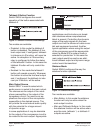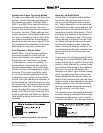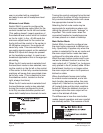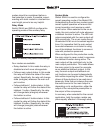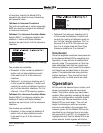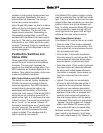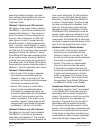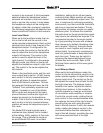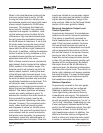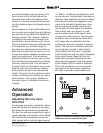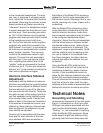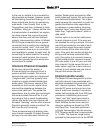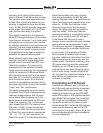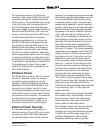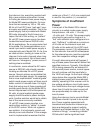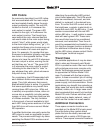
Issue 1, September 2007 Model 233 User Guide
Page 32 Studio Technologies, Inc.
When in the level/balance mode and the
minimum output level is set to –40 dB,
turning the level control to its fully coun-
terclockwise position will place both head-
phone output channels to 40 dB below
maximum. This ensures that talent will
never be fully “isolated” from potentially
important cue signals. In addition, rotat-
ing the balance control to either its fully
clockwise or fully counterclockwise posi-
tion will cause the applicable channel to
be 40 dB below its maximum. If set to the
full mute mode, turning the level control
to its fully counterclockwise position will
cause both the left and right channels to
fully mute. In addition, rotating the balance
control to either its fully clockwise or fully
counterclockwise position will cause the
applicable channel to fully mute.
Both of these controls have a mechanical
step (detent) that is located at the halfway
(50%) position of its rotation range. The
balance control will typically be set to its
center, detent position, making the level
of the left and right channels equal. In an
ideal installation, the level control can also
be set to its detent position and provide a
comfortable headphone output level. This
will allow the user, in response to their
preference or a changing environment, to
adjust the level and balance controls as
desired. The detent positions will always
remain as a useful reference point. To
achieve this condition the audio levels on
the connected line inputs must be ad-
justed as required. Spending a few extra
minutes “trimming” the connected audio
levels, rather than just providing what-
ever happens to come up, should prove
worthwhile. The result will be talent that is
more relaxed, and an overall production
that works more smoothly. As previously
mentioned, a level trim potentiometer is
associated with each line input. If the line
inputs are utilized as cue sources, adjust-
ing the trim pots may be helpful in achiev-
ing the desired adjustment range of the
level controls. Refer to the Technical Notes
section of this user guide for details.
Monaural Headphone Output Level
Control Operation
As previously discussed, the headphone
output can be set for monaural operation.
This option is specifically provided so
that a headphone mix mode can be cre-
ated. If this has been enabled, the three
front-panel level controls are used as a
cue source mixer. Independent cue inputs
will be assigned to the control on the far
left and the control in the center channel,
serving as two of the mix sources. How
these two controls respond when placed
in their fully counterclockwise position will
depend on the configuration. By default
the output level will be 40 dB below its
maximum level. An alternate configuration
will make the outputs mute. The control on
the far right, sidetone, will always maintain
the same function. It is used to add signal
associated with the microphone input to
the headphone output as desired.
Sidetone Operation
As previously covered in this user guide,
a sidetone function can be configured.
Sidetone is defined as the user’s own
voice signal being returned to them as
a headphone cue source. This helps the
user create a more effective performance
as well as possibly receiving an “on-air” or
“you’re live” indication. Depending on how
it was configured, sidetone audio will be
sent to the left headphone output, the right
headphone output, or both the left and
right headphone outputs. In addition, the
side tone function can be configured so
that it is active only when the main output
is active, or whenever the main output or



